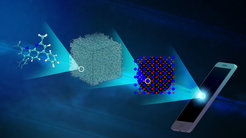A library of … organic molecules
How modern algorithms can be used to improve organic light-emitting diodes
From modern smartphones to televisions: organic light-emitting diodes (OLEDs) are an emerging technology that promises, among other benefits, excellent image contrast and low power consumption. The complexity of an OLED pixel makes it difficult to design new molecular materials. Denis Andrienko, group leader at the Max Planck Institute for Polymer Research, and his team have now compared a wide range of computer-simulated and experimentally measured properties of OLED thin films, trying to understand whether OLED design can be guided solely by computer.
In contrast to conventional light-emitting diodes (LEDs), organic LEDs (OLEDs) are no longer made of silicon. In OLEDs, thin layers of carbon-based molecules form pixels, which emit light. The color of a pixel can be adjusted by varying the molecular structure. OLED pixels normally consist of multiple layers which ensure, for example, that electrons can travel in the pixel with as little resistance as possible. The fine-tuning of the layer properties, for example, electron mobility or the emitted wavelength (color of the light), is a complex task.

The properties of OLEDs based on the structure of the molecules used could be predicted in the future entirely by computer simulations.
Denis Andrienko, group leader at the Max Planck Institute for Polymer Research (MPI-P) in the department "Theory of Polymers" headed by Prof. Kurt Kremer, has now joined forces with scientists of the Ukrainian Institute of Physics, the department of Molecular Electronics at MPI-P, as well as Merck KGaA, Darmstadt, Germany. Together, they tested the accuracy of computer-based predictions of properties of thin OLED layers.
For this purpose, they have established a molecular library of typical OLED materials. The idea of this library is to streamline the design of new molecular structures and to simulate the properties of the corresponding thin layers. The benefit is that this can be done prior to (expensive) synthesis, layer deposition, and characterization of an entire OLED.
"In the future, we hope that our simulation protocols can be used to design molecular structures with given properties," the co-author of the paper, Leanne Paterson, says.
The scientists simulated and measured various parameters of OLED layers and found good correlations for some properties and consistent trends for others. Their results are now published in Chemical Physics Reviews and highlighted on AIP's Scilight. The material library is open for other researches and can be downloaded from the GitLab of the Max Planck Computing and Data Facility.












